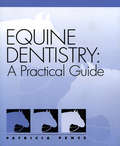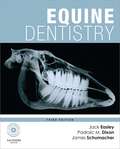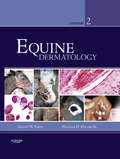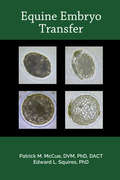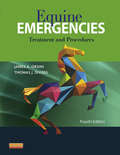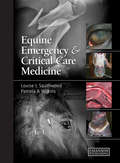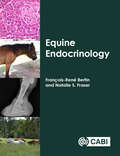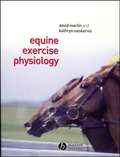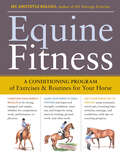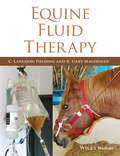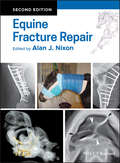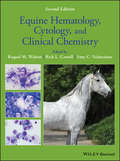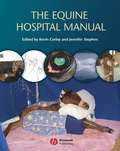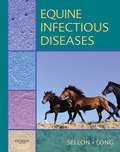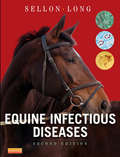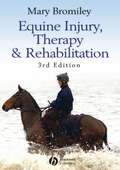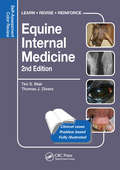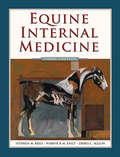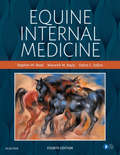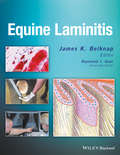- Table View
- List View
Equine Dentistry: A Practical Guide
by Patricia PenceDesigned for the practitioner in the field or the clinic, this quick reference manual provides medical and surgical guidance in a practical, concise manner. Procedural in its approach, this text contains many tables, charts and lists, and step-by-step procedures, diagnostic evaluation, and medical and surgical management of all dental problems in the horse.
Equine Dentistry - E-Book
by Mvb PhD Mrcvs, James Schumacher, Dvm Ms Mrcvs Di Dvm Ms Dipl Abvp Equine Padraic DixonA compilation of a wide range of topics discussed by world-renowned experts in the field of equine dentistry. The new edition of this popular resource represents a total revision of previous content and provides the reader with state-of-the-art knowledge of the field. Comprehensive and definitive, Equine Dentistry third edition retains the successful approach of extensive illustration and step-by-step guidance through oral and dental procedures. In addition, it includes many new figures, expanded text sections in key areas and brings to the team two new editors of international repute. Many new contributions from international experts are combined in this text to promote not only the care of horses in regards to oral and dental health but also the education of veterinary professionals in this rapidly developing area.Jack Easley is joined by James Schumacher and Padraic Dixon in the editorial team Seven new chapters reflect the major advances in dental anatomy and disease and also more general advances in analgesia and anesthesia, diagnostic imaging, and dental surgery The brand-new DVD provides visual as well as vocal guidance to techniques of equine dental examination and prophylactic treatment
Equine Dermatology - E-Book
by Danny W. Scott William H. Miller Jr.Diagnose, treat, and manage equine skin disorders with the most comprehensive reference available! With 900 full-color photos, Equine Dermatology covers skin diseases ranging from those that merely annoy the horse to others that interfere with the horse's ability to function in riding, working, or show. Thorough coverage includes essential basics and practical diagnostic methods, therapies, and specific abnormalities and defects. The book describes the structure and function of the skin, and discusses disorders including bacterial, fungal, parasitic, viral, protozoal, allergic, immune-mediated, endocrine, metabolic, and nutritional diseases. It also covers congenital and hereditary defects, pigmentation abnormalities, keratinization defects, environmental skin diseases, and skin tumors. Written by renowned equine dermatologists Danny Scott and Bill Miller, this all-inclusive resource covers the latest dermatologic topics and the newest therapies.Current, comprehensive coverage includes every known equine dermatosis.An emphasis on differential diagnosis includes key differentials and breed predilections for each disease, especially helpful when you have only a specimen and an incomplete history to work with.A consistent format makes it easy to locate information on each skin disorder, including a clinical description, its cause and pathogenesis, clinical features, clinical management, diagnosis, treatment, and any zoonotic aspects.Expert authors Danny W. Scott, DVM, and William H. Miller, Jr., VMD, offer years of knowledge, experience, and their vast image collections.Diagnostic tables in each chapter provide a quick reference for identifying lesions and disorders.An extensive list of references at the end of each chapter includes recommendations for further reading. New coverage of dermatologic conditions includes the latest topics and emerging disorders such as chronic progressive lymphedema, herpesvirus-2-associated dermatitis, salmonella-associated dermatoses, and nodular auricular chondropathy.Updated Diagnostic Methods chapter covers multiple methods of developing a differential diagnosis list based on breed, lesion type, patterns, and location.A focus on common clinical problems highlights the conditions most likely to be seen in practice. Almost 1,000 full-color photos of skin disorders make it easy to distinguish clinical characteristics and variations of normal and abnormal for accurate diagnosis and therapy.
Equine Embryo Transfer
by Patrick M. McCue Edward L. SquiresThis book briefly reviews the history of equine embryo transfer, covering in clinically practical terms the techniques, equipment, and management protocols currently in use. Embryo transfer has become a big business, especially for breeding racing stock (horses and camels), and is therefore a very important aspect of equine practice. Ed Squires and
Equine Emergencies E-Book: Treatment and Procedures
by James A. Orsini Thomas J. DiversIdeal for use in the clinic and in the field, Equine Emergencies: Treatment and Procedures, 4th Edition, offers practical step-by-step guidelines for effectively managing a wide range of emergency situations. Thoroughly updated content keeps you informed of the latest advances in horse care in a portable, convenient format.Essential examination, diagnostic, and treatment information for each body system is presented in a logical format so you can quickly find answers during equine emergencies.What to Do and What Not to Do boxes guide you through the step-by-step treatment of an emergency and draw your attention to important steps to take and those to avoid.High-quality photographs and illustrations visually clarify key concepts and guide you through procedures step by step.NEW! Chapter covering bacterial and viral diseases arms you with critical information on diagnostic labs, collection, submission, and interpretation.NEW! Chapter on emergency diagnostic procedures keeps you up-to-date on all the tests needed to determine the most effective treatment.NEW! Chapter on gene testing provides information on which gene tests and labs should be performed.NEW! Chapter on biopsy techniques highlights the different instruments available, endoscopic and laparoscopic techniques, as well as how to perform a pleuritis examination.NEW! Chapter on laboratory submission offers the latest information on tests, laboratory charts, guidelines for making an appropriate submission, and blood drawing.NEW! Chapters on feeding and starvation and flood injury supply the latest guidelines for nutrition, disaster medicine, and snake bites/envenomation.
Equine Emergency and Critical Care Medicine
by Louise Southwood Liberty Getman Gary Magdesian James Orsini Robert Poppengay Dean W. Richardson Barbara Dallap Schaer Janice Seahorn Troy Trumble Mary Utter Dietrich Volkmann Pamela A. Wilkins Jane Axon Michelle Henry-Barton Brett Tennett-Brown Vanessa Cook Elizabeth Davidson Melinda Frye Mathew GerardEarly recognition of problems by owners, appropriate first aid, and timely referral by field veterinarians improve the chance of survival for horses requiring emergency management and critical care. With a view toward improving patient outcome, Equine Emergency and Critical Care Medicine is written by a team of enthusiastic equine specialists who e
Equine Endocrinology
by François-René Bertin Natalie S FraserThis book provides a practical, clinical approach to diagnosing, treating, and managing endocrine diseases in the horse. Each chapter uses the same structure to form a user-friendly tool of information and advice on aetiology, pathophysiology, clinical presentation, diagnosis and treatment for each endocrine disorder. This book covers: - approaches to endocrine disorders; - diseases of the hypothalamo-pituitary-thyroid axis; - disorders in calcium regulation and diseases of the parathyroid gland; - diseases of the hypothalamo-pituitary-adrenocortical axes; - diseases of the endocrine pancreas and Equine Metabolic Syndrome; - hyperlipaemia and lipid metabolism disorders; and - endocrine disorders associated with the female and male reproductive systems. This book also includes material on additional endocrinopathies, such as diabetes insipidus and pheochromocytoma, and is dedicated to the fast-moving field of equine endocrinology. Written by world-leading international experts, it collates their insights and experience into approaches that prove invaluable for general equine practitioners.
Equine Exercise Physiology
by David Marlin Kathryn J. NankervisEquine exercise physiology is an area that has been subject to major scientific advances over the last 30 years, largely due to the increased availability of high-speed treadmills and techniques for recording physiological function during exercise. Despite the scientific advances, many riders and trainers are still using little more than experience and intuition to train their horses. The aim of this book is to sort the fact from the fiction for the benefit of those involved in training, managing or working with horses, and to provide an up-to-date summary of the state of play in equine exercise physiology. Scientific theories are explained from first principles, with the assumption that the reader has no previous scientific background. The book is designed to save competitors and trainers a lot of time and effort trying to extract information in piecemeal fashion from a host of reference sources. For the first time, everything you need to know about exercising and training horses is here in one text.
Equine Exercise Physiology
by David Marlin Kathryn J. NankervisEquine exercise physiology is an area that has been subject to major scientific advances over the last 30 years, largely due to the increased availability of high-speed treadmills and techniques for recording physiological function during exercise. Despite the scientific advances, many riders and trainers are still using little more than experience and intuition to train their horses. The aim of this book is to sort the fact from the fiction for the benefit of those involved in training, managing or working with horses, and to provide an up-to-date summary of the state of play in equine exercise physiology. Scientific theories are explained from first principles, with the assumption that the reader has no previous scientific background. The book is designed to save competitors and trainers a lot of time and effort trying to extract information in piecemeal fashion from a host of reference sources. For the first time, everything you need to know about exercising and training horses is here in one text.
Equine Fitness: A Program of Exercises and Routines for Your Horse
by Jec Aristotle BallouGet your horse in shape and maintain his overall fitness, regardless of his age or abilities. Equine Fitness will have your horse looking and feeling his best with a series of fun exercise routines specifically designed to enhance his strength, stamina, and agility. Clear step-by-step instructions and detailed illustrations make the exercises easy to follow, and the book includes a handy set of pocket-sized cards that you can use in the ring. Jec Ballou&’s simple conditioning program promises lasting results for healthy horses and satisfied riders.
Equine Fluid Therapy
by C. Langdon Fielding K. Gary MagdesianEquine Fluid Therapy is the first reference to draw equine-specific fluid therapy information together into a single, comprehensive resource. Offering current information unique to horses on the research and practice of fluid, electrolyte, and acid-base disorders, the book is designed to be clinically oriented yet thorough, providing detailed strategies tailored to equine practice. With information ranging from physiology and acid-base balance to fluid therapy for specific conditions, Equine Fluid Therapy covers fluid treatments in both adult horses and foals, highlighting the unique physiologic features, conditions, and differences in foals. Well-illustrated throughout, the book begins with an overview of the physiology of fluids, electrolytes, and acid-base, then moves into practical information including equipment, monitoring techniques, fluid choices, and potential complications. A final section offers chapters on blood transfusions, colloids, parenteral nutrition, and hemodynamic monitoring. Equine Fluid Therapy is an essential reference for equine practitioners, specialists, and researchers.
Equine Fluid Therapy
by C. Langdon Fielding K. Gary MagdesianEquine Fluid Therapy is the first reference to draw equine-specific fluid therapy information together into a single, comprehensive resource. Offering current information unique to horses on the research and practice of fluid, electrolyte, and acid-base disorders, the book is designed to be clinically oriented yet thorough, providing detailed strategies tailored to equine practice. With information ranging from physiology and acid-base balance to fluid therapy for specific conditions, Equine Fluid Therapy covers fluid treatments in both adult horses and foals, highlighting the unique physiologic features, conditions, and differences in foals. Well-illustrated throughout, the book begins with an overview of the physiology of fluids, electrolytes, and acid-base, then moves into practical information including equipment, monitoring techniques, fluid choices, and potential complications. A final section offers chapters on blood transfusions, colloids, parenteral nutrition, and hemodynamic monitoring. Equine Fluid Therapy is an essential reference for equine practitioners, specialists, and researchers.
Equine Fracture Repair
by Alan J. NixonOffers a long-awaited Second Edition of this comprehensive, state-of-the-art reference for fracture repair in horses The Second Edition of Equine Fracture Repair has been thoroughly revised and updated to present the most current information on fracture repair in horses. Written to be accessible, the text is logically arranged, presenting the most authoritative information on equine fracture repair with explanations of the expected outcomes. The book provides valuable insight as to whether a fracture should be repaired, the degree of difficulty of the procedure, and a wealth of practical information on surgical techniques. This fully revised Second Edition offers a valuable tool for veterinarians making clinical decisions when faced with horse fractures, covering emergency care and splinting, the most current innovative techniques in equine fracture repair, and new implant systems. With contributions from leading experts in the field, the revised edition continues to be the essential reference to the subject. This essential resource: Offers a revised edition of the most comprehensive reference on the repair of fracture in horses, with complete information on patient assessment, emergency splinting and casting, and guidance in treatment choices Includes contributions from leading experts in the field Presents information organized by fracture type for quick access Provides valuable outcome assessment with helpful discussions of the degree of difficulty to aid in case management, incorporating information on the newest techniques and implant systems Concludes with extensive information on the identification and management of complications associated with fractures and repair methods This revised and updated edition of Equine Fracture Repair continues to provide a comprehensive resource for understanding the most effective and current techniques available for the treatment of fractures in horses.
Equine Fracture Repair
by Alan J. NixonOffers a long-awaited Second Edition of this comprehensive, state-of-the-art reference for fracture repair in horses The Second Edition of Equine Fracture Repair has been thoroughly revised and updated to present the most current information on fracture repair in horses. Written to be accessible, the text is logically arranged, presenting the most authoritative information on equine fracture repair with explanations of the expected outcomes. The book provides valuable insight as to whether a fracture should be repaired, the degree of difficulty of the procedure, and a wealth of practical information on surgical techniques. This fully revised Second Edition offers a valuable tool for veterinarians making clinical decisions when faced with horse fractures, covering emergency care and splinting, the most current innovative techniques in equine fracture repair, and new implant systems. With contributions from leading experts in the field, the revised edition continues to be the essential reference to the subject. This essential resource: Offers a revised edition of the most comprehensive reference on the repair of fracture in horses, with complete information on patient assessment, emergency splinting and casting, and guidance in treatment choices Includes contributions from leading experts in the field Presents information organized by fracture type for quick access Provides valuable outcome assessment with helpful discussions of the degree of difficulty to aid in case management, incorporating information on the newest techniques and implant systems Concludes with extensive information on the identification and management of complications associated with fractures and repair methods This revised and updated edition of Equine Fracture Repair continues to provide a comprehensive resource for understanding the most effective and current techniques available for the treatment of fractures in horses.
Equine Hematology, Cytology, and Clinical Chemistry
by Raquel M. Walton Rick L. Cowell Amy C. ValencianoThe all-new Equine Hematology, Cytology, and Clinical Chemistry draws on hematology and clinical chemistry information featured in the first edition of Equine Clinical Pathology and adds valuable cytopathology material from Diagnostic Cytology and Hematology of the Horse, making it a truly definitive reference to clinical pathology in equids. Thoroughly updated and expanded throughout, this Second Edition offers more images, more information, and new knowledge for previous chapters and entirely new chapters on bone marrow evaluation and cytopathology. Designed to present clear, concise, and clinically relevant information, the book is logically organized for easy reference. Numerous figures, tables and images support the text, together with summarized information for ease of use. Offers a focus on clinical pathology in the horse, with in-depth information on hematology, clinical chemistry, and cytopathology in equids Presents equine disease from a systems-based, clinicopathological perspective Features hundreds of high-quality images Includes contributions from veterinary specialists with expert knowledge of clinical pathology A must-have purchase for anyone using hematology, clinical chemistry, and cytology in equine patients, Equine Hematology, Cytology, and Clinical Chemistry, 2nd Edition is a valuable resource for equine practitioners, clinical pathologists and residents, and veterinary students.
Equine Hematology, Cytology, and Clinical Chemistry
by Raquel M. Walton Rick L. Cowell Amy C. ValencianoThe all-new Equine Hematology, Cytology, and Clinical Chemistry draws on hematology and clinical chemistry information featured in the first edition of Equine Clinical Pathology and adds valuable cytopathology material from Diagnostic Cytology and Hematology of the Horse, making it a truly definitive reference to clinical pathology in equids. Thoroughly updated and expanded throughout, this Second Edition offers more images, more information, and new knowledge for previous chapters and entirely new chapters on bone marrow evaluation and cytopathology. Designed to present clear, concise, and clinically relevant information, the book is logically organized for easy reference. Numerous figures, tables and images support the text, together with summarized information for ease of use. Offers a focus on clinical pathology in the horse, with in-depth information on hematology, clinical chemistry, and cytopathology in equids Presents equine disease from a systems-based, clinicopathological perspective Features hundreds of high-quality images Includes contributions from veterinary specialists with expert knowledge of clinical pathology A must-have purchase for anyone using hematology, clinical chemistry, and cytology in equine patients, Equine Hematology, Cytology, and Clinical Chemistry, 2nd Edition is a valuable resource for equine practitioners, clinical pathologists and residents, and veterinary students.
The Equine Hospital Manual
by Kevin Corley Jennifer StephenThe must-have resource drawing together all aspects of hospital care of the horse and specialist techniques in equine medicine. Written by a team of over 30 international experts working at the cutting edge of equine medicine and surgery. The emphasis is on practical, easy-to-access information, with a sound basis in evidence based medicine and full references for further enquiry. The Equine Hospital Manual covers the range of procedures used on hospitalized adult horses and foals from the simple to the advanced. The book is liberally illustrated with photographs and line drawings. Covering: Basic skills including physical examination, blood collection, and bandaging Advanced skills including mechanical ventilation, lung biopsy and cardiac output measurement Designing and setting up an equine hospital Biosecurity Therapeutic drugs used in horses and their doses Nutrition for hospital patients, including TPN and PPN Fluid therapy – choices, amounts and pitfalls Anaesthesia – equipment, techniques and post-operative care including analgesia Reflecting the substantial trend in recent years to treat horses in a hospital rather than in the field, this book provides all you need to know whether you have facilities to treat one or one hundred horses.
Equine Infectious Diseases E-Book
by Debra C. Sellon Maureen LongIdeal for both practitioners and students, this comprehensive resource covers the diagnosis, treatment, and prevention of infectious disease in horses. Organized by infectious agent — virus, bacterial and rickettsial, protazoal, and fungal — it includes complete coverage of the individual diseases caused by each type of agent. A section on clinical problems examines conditions such as ocular infections, CNS infections, and skin infections. It also addresses the importance of preventing and controlling infectious disease outbreaks with coverage of epidemiology, biosecurity, antimicrobial therapy, and recognizing foreign equine diseases.Full-color photos and illustrations provide clear, accurate representations of the clinical appearance of infectious diseases.Features the most recent information on the global threat of newly emergent diseases such as African Horse Sickness.Includes a comprehensive section on the prevention and control of infectious diseases.More than 60 expert contributors share their knowledge and expertise in equine infectious disease.A companion CD-ROM, packaged with the book, includes complete references linked to PubMed.
Equine Infectious Diseases E-Book
by Debra C. Sellon Maureen LongIdeal for both practitioners and students, this comprehensive resource covers the diagnosis, treatment, and prevention of infectious disease in horses. Organized by infectious agent — virus, bacterial and rickettsial, protazoal, and fungal — it includes complete coverage of the individual diseases caused by each type of agent. A section on clinical problems examines conditions such as ocular infections, CNS infections, and skin infections. It also addresses the importance of preventing and controlling infectious disease outbreaks with coverage of epidemiology, biosecurity, antimicrobial therapy, and recognizing foreign equine diseases.Full-color photos and illustrations provide clear, accurate representations of the clinical appearance of infectious diseases.Features the most recent information on the global threat of newly emergent diseases such as African Horse Sickness.Includes a comprehensive section on the prevention and control of infectious diseases.More than 60 expert contributors share their knowledge and expertise in equine infectious disease.A companion CD-ROM, packaged with the book, includes complete references linked to PubMed.
Equine Injury, Therapy and Rehabilitation
by Mary BromileyMary Bromiley’s book remains essential reading for both professionals and the general riding community. This new edition builds on the huge success of the previous editions, first published in 1987. Fully updated to reflect recent technological advances in diagnostic ability, as well as the proven physiological effects of light, magnetic fields and electrical currents on body tissues. This information allows readers to both understand and make an informed choice of appropriate therapy following a diagnosed injury. The original edition was the first book on the subject and it has continued to be a bestseller. Covers a subject that is of worldwide interest. The author is recognised as a pioneer at the forefront of this type of treatment.
Equine Injury, Therapy and Rehabilitation
by Mary BromileyMary Bromiley’s book remains essential reading for both professionals and the general riding community. This new edition builds on the huge success of the previous editions, first published in 1987. Fully updated to reflect recent technological advances in diagnostic ability, as well as the proven physiological effects of light, magnetic fields and electrical currents on body tissues. This information allows readers to both understand and make an informed choice of appropriate therapy following a diagnosed injury. The original edition was the first book on the subject and it has continued to be a bestseller. Covers a subject that is of worldwide interest. The author is recognised as a pioneer at the forefront of this type of treatment.
Equine Internal Medicine: Self-Assessment Color Review Second Edition (Veterinary Self-assessment Color Review Ser.)
by Tim S. Mair Thomas J. DiversWritten by well-respected experts from the UK and USA, Equine Internal Medicine: Self-Assessment Color Review Second Edition presents more than 200 interesting and challenging cases encountered in equine practice, complete with photographs, imaging, or endoscopy findings; blood or fluid smears; other ancillary tests; and, in some cases, pathologic
Equine Internal Medicine - E-Book
by Stephen M. Reed Warwick M. Bayly Debra C. SellonDevelop an essential understanding of the principles of equine disease with this one-of-a-kind, problem-based resource! Extensively revised and updated with contributions from an international team of experts, Equine Internal Medicine, 3rd Edition reflects the latest clinical research in equine medicine and focuses on the basic pathophysiologic mechanisms that underlie the development of various equine diseases to help you confidently diagnose, treat, and manage patient conditions. Problem-based approach outlines how to apply the latest clinical evidence directly to the conditions you’ll encounter in practice. Pathophysiology is emphasized throughout, providing a sound basis for discussions of the diagnosis, treatment, and prognosis that follow.Body systems chapters begin with a thorough discussion of the diagnostic method appropriate to the system, including physical examination, clinical pathology, radiography, endoscopy, and ultrasonography.Flow charts, diagrams, and algorithms clarify complex material. Extensive content updates help you improve patient care with up-to-date research and clinical evidence across the full spectrum of equine practice, including: New sections on biofilm ahesins, resistance to phagocytosis, and host substrate utilizationNew information on changes in body weightRecent findings on fibrocoxib and diclofenacExpanded and reorganized coverage of critical careNew material on inborn errors of metabolism and acquired myopathiesDetailed treatment information on various disorders of the reproductive tractA new section on toxicoses causing signs related to liver disease or dysfunction Bound-in companion DVD includes more than 120 high-quality video clips that guide you through procedures related to the cardiovascular and neurologic systems.
Equine Internal Medicine - E-Book
by Stephen M. Reed Warwick M. Bayly Debra C. SellonConfidently diagnose, treat, and manage patient conditions with the only comprehensive book on the market devoted solely to equine internal medicine. Filled with fully updated content on principles of treatment and contributions from internationally known equine experts, Equine Internal Medicine, 4th Edition focuses on the basic pathophysiologic mechanisms that underlie the development of various equine diseases. A problem-based approach outlines how to apply the latest clinical evidence directly to the conditions you will encounter in practice. A new companion website with over 120 video clips presents diseases and disorders that cannot be explained as well through wordsUpdated information throughout, including the most recent drug information. Current and well-referenced content on equine diseases and treatment techniques cites the latest books and journals.Internationally known equine experts present information on problems affecting horses throughout the world — and provide contributions that enable practitioners and students to approach disease and treatment of equine patients with more authority and understanding. User-friendly exterior and interior design makes the book appealing to both the equine internal medicine practitioner and the veterinary student. Easy-to-find information facilitates a more thorough understanding with minimal frustration.Organized and consistent coverage among chapters allows you to easily find information on a specific topic.NEW! Fully updated and revised sections on disorders and principles of treatment.NEW! Problem-based approach outlines how to apply the latest clinical evidence directly to the conditions you will encounter in practice. NEW! Pathophysiology is emphasized throughout, providing a sound basis for discussions of the diagnosis, treatment, and prognosis that follow. NEW! Body systems chapters begin with a thorough discussion of the diagnostic method appropriate to the system, including physical examination, clinical pathology, radiography, endoscopy, and ultrasonography. NEW and UNIQUE! Companion website includes more than 120 video clips linked to content from chapters on cardiovascular and neurologic system disorders.NEW! Flow charts, diagrams, and algorithms clarify complex material.
Equine Laminitis
by Raymond J. GeorThe first book dedicated to this common, serious, and complex equine disease, Equine Laminitis is the gold-standard reference to the latest information on every aspect of the disease and its treatment. Provides the first book devoted specifically to equine laminitis Discusses the current state of knowledge on all aspects of the disease, including its history, relevant anatomical considerations, pathophysiology, the diagnostic workup, and clinical treatment Presents 50 chapters written by leading international experts, under the editorship of the foremost authority on equine laminitis Offers a thorough understanding of this common affliction, grounded in the scientific literature Describes effective prevention and treatment plans
